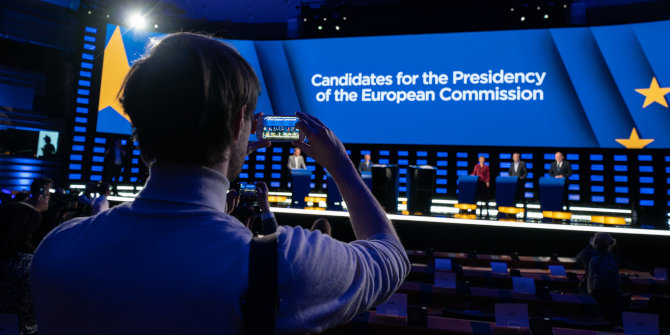
 The Spitzenkandidaten process, which was first used in the 2014 European Parliament elections, is intended to boost voter awareness and participation. But does it live up to these aims? Drawing on a new study, Katjana Gattermann and Franziska Marquart find evidence that while the Spitzenkandidaten procedure itself might not influence electoral participation, individual candidates can still matter for voters’ choices.
The Spitzenkandidaten process, which was first used in the 2014 European Parliament elections, is intended to boost voter awareness and participation. But does it live up to these aims? Drawing on a new study, Katjana Gattermann and Franziska Marquart find evidence that while the Spitzenkandidaten procedure itself might not influence electoral participation, individual candidates can still matter for voters’ choices.
Spitzenkandidaten are political candidates nominated by major European party families for European Parliament (EP) elections. The candidate whose party family gains the most votes in these elections has a good chance to become the new President of the European Commission (like Jean-Claude Juncker in 2014). In order to advertise their pan-European candidates, parties focus some of their campaign attention on the Spitzenkandidaten, a strategy that aligns with the increasing personalisation of politics across the world.
Proponents of this procedure at the European level had been enthusiastic about its alleged impact on voter awareness and participation: Spitzenkandidaten could potentially make the distant Brussels bureaucracy more tangible to European citizens and put a human face on abstract political procedures. Ursula von der Leyen’s election as Commission President after the 2019 elections challenged the Spitzenkandidaten procedure (as she had not been her party’s candidate during the campaign), but the question remains whether the personalisation of the campaigns succeeded in influencing European voters.

Debate between Spitzenkandidaten ahead of the 2019 European Parliament elections, Credit: CC BY 4.0: © European Union 2019 – Source: EP
In a recent study, we shed light on the alleged impact of the Spitzenkandidaten in European Parliament elections and ask: What are the effects of personalised EP election campaigns centred on Spitzenkandidaten on European citizens’ a) participation in EP elections and b) intention to vote for the advertising party? To answer these questions, we set up an original online experiment in the Netherlands and Germany in early April 2019, before the final phase of the EP election campaigns had begun. In this experiment, we presented participants with fictional poster campaigns of real candidates, namely the two Spitzenkandidaten of the European Greens, the Dutchman Bas Eickhout and the German Ska Keller.
This allowed us to tease out potential nationality effects: Are citizens more willing to support a candidate from their own country? We also controlled for gender effects by adding another Green candidate with a different gender from each country. We tested whether exposure to campaign posters of an individual candidate versus exposure to posters that only mention the European Greens resulted in higher levels of turnout intention and vote intention for the European Greens, respectively. We also assessed how respondents evaluated the posters alongside their attitudes towards the candidates.
In our experiment, respondents were randomly assigned to one out of four political poster campaigns. The content of the posters differed between conditions in the following way: Respondents in condition 1) saw three posters showing the national Spitzenkandidat (Bas Eickhout in the Netherlands, Ska Keller in Germany); posters in condition 2) featured the other European Spitzenkandidat; condition 3) showed another national Green candidate (Jeroni Vergeer (NL) or Sven Giegold (DE)); and condition 4) provided posters mentioning only the party. We made use of the candidates’ real photographs that are available online, but crated fictitious slogans based on the online communication of the European Greens and respective national parties.
Personalised vs Party campaigns
Our results show that there are no differences between effects of exposure to candidate- and party-centred campaigns on behavioural intentions in EP elections: Respondents in either condition were similarly likely to participate in the upcoming elections. However, poster campaigns that advertised a candidate in contrast to the party were evaluated less favourably – and subsequently, citizens’ reported lower turnout intentions.
While this finding runs counter to our expectations, we believe that the European Greens are a special case because they exhibit strong issue ownership on environmental issues and do not represent catch-all parties. Thus, candidates may be less important than issues. Similarly, voters may already hold clear positions towards Green parties and their electoral programmes, which may be why it makes no difference for electoral behaviour whether the campaign focuses on candidates or parties.
Green party posters may also elicit a stronger focus on the message, while personalised posters could be perceived as prioritising candidates over issues – if (Green) voters consider personalisation as a negative campaign strategy, they may punish the advertiser and feel less mobilised to turn out in European elections. In other words, a personalisation effect is still present, but it is driven by negative rather than positive campaign evaluations.
Individual candidates can make a difference
However, we also found that respondents who evaluated a candidate more positively were more likely to vote for the Greens. Interestingly, voters did not distinguish between candidates’ nationality – it does not matter whether a Spitzenkandidat comes from the same member state as the respondents. Possibly, this may be attributable to the fact that European citizens are not very aware of them in the first place. At the same time, female candidates – particularly Ska Keller – received better evaluations in our sample and were responsible for a higher voting intention for the Greens. Hence, while personalised campaigns may not matter per se in comparison to party campaigns, individual candidates can make a difference in EP elections
The 2019 EP elections provided us with an excellent opportunity to study real Spitzenkandidaten, even though the campaigns we created were designed for the purpose of this study alone. It is possible that such campaigns may have different effects in countries lacking their own Spitzenkandidaten or with different political cultures (e.g., regarding male and female candidates). Likewise, our results are not generalisable to other candidates or parties standing in EP elections. We argue that political posters still play an important role in election campaigns across Europe, but acknowledge that their impact within a larger campaign can be additive at best, in the sense that they work as “visual reminders” of the upcoming Election Day.
We sought to provide a thorough test of personalisation effects, and our results paint a nuanced picture: While the Spitzenkandidaten procedure itself did not influence electoral participation, individual candidates can matter for voter choice. We recommend to further explore the opportunities of personalised campaigns in EP elections with carefully chosen individual candidates – for instance as part of a revised Spitzenkandidaten procedure as discussed during the investiture of Ursula von der Leyen.
For more information, see the authors’ accompanying paper in European Union Politics
Please read our comments policy before commenting.
Note: This article gives the views of the authors, not the position of EUROPP – European Politics and Policy or the London School of Economics.
_________________________________
 Katjana Gattermann – University of Amsterdam
Katjana Gattermann – University of Amsterdam
Katjana Gattermann is an Assistant Professor of Political Communication and Journalism at the Amsterdam School of Communication Research (ASCoR), Department of Communication Science, University of Amsterdam. Her research interests comprise political communication and journalism, public opinion and political behaviour with a regional focus on the European Union. She is currently leading a research project entitled ‘Facing Europe: The personalization of European Union politics in news coverage and its consequences for democracy’, which is funded by the Netherlands Organisation for Scientific Research. She is the Convenor of the ECPR Standing Group ‘Political Communication’, which she co-founded as a Research Network in 2017. Her work has appeared in journals such as the European Journal of Political Research, European Union Politics, the International Journal of Press/Politics, the Journal of European Public Policy, and West European Politics.
 Franziska Marquart – University of Amsterdam
Franziska Marquart – University of Amsterdam
Franziska Marquart is a Postdoctoral Researcher at the Political Communication and Journalism research group at the Amsterdam School of Communication Research (ASCoR), Department of Communication Science, University of Amsterdam. She works in the ERC-funded project EUROPINIONS led by Claes de Vreese, which investigates the antecedents and consequences of public opinion towards the European Union. She earned her PhD from the University of Vienna in Austria, where she was part of the Advertising and Media Effects research group. Her research focuses on political communication effects, experimental methods, and the impact of visual communication in various mediated contexts. Her work has been published in journals such as Communication Research, West European Politics, the Journal of Media Psychology, the Journal of European Integration, and Communication Methods and Measures.




